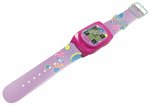Barbie Math Bracelet
Mathematic and verbal skill games with animation on an LCD screen
 Wear this fashionable B-Smart Bracelet and learn the secrets of mathematics the Barbie way. Digital sound Barbie voice guides girls through challenging math and fun word game modes with animation on a high resolution LCD screen. The B-Smart Bracelet has added features with talking analog time display. For Ages 5 and up. Little girls who like Barbie and computerized games will appreciate this dark-pink-and-lavender watch with both digital and analog time displays. An animated version of Barbie's face appears on the tiny square LCD screen, with her voice announcing, Hi, it's Barbie. Let's start having fun, or You're my very best friend. When the clock button is pressed, Barbie's voice says, It is 10:21 a.m. Good morning. Have a great day. The simple addition or subtraction games start with a short animated sequence of one item (a cake, heart, cat, puppy, ring, or shoes) and then a simple addition or subtraction problem follows with Barbie's voice reading the equation as a story problem. Four possible answers are displayed and Barbie provides either positive reinforcement (You did it) for a correct answer or encouragement to try again (Come on, you can do it). The math facts are at late first grade or second grade level, but younger girls might like to play the math games with the help of an adult or older sibling.
Wear this fashionable B-Smart Bracelet and learn the secrets of mathematics the Barbie way. Digital sound Barbie voice guides girls through challenging math and fun word game modes with animation on a high resolution LCD screen. The B-Smart Bracelet has added features with talking analog time display. For Ages 5 and up. Little girls who like Barbie and computerized games will appreciate this dark-pink-and-lavender watch with both digital and analog time displays. An animated version of Barbie's face appears on the tiny square LCD screen, with her voice announcing, Hi, it's Barbie. Let's start having fun, or You're my very best friend. When the clock button is pressed, Barbie's voice says, It is 10:21 a.m. Good morning. Have a great day. The simple addition or subtraction games start with a short animated sequence of one item (a cake, heart, cat, puppy, ring, or shoes) and then a simple addition or subtraction problem follows with Barbie's voice reading the equation as a story problem. Four possible answers are displayed and Barbie provides either positive reinforcement (You did it) for a correct answer or encouragement to try again (Come on, you can do it). The math facts are at late first grade or second grade level, but younger girls might like to play the math games with the help of an adult or older sibling.
The Evolution of Electronic Watches into Smart Watches
The journey from electronic watches to smartwatches is a fascinating reflection of the convergence of technology, fashion, and daily utility. This evolution spans several decades, highlighting the rapid advancement of technology and the changing demands of consumers.
- Electronic Watches: The first electronic watches, introduced in the 1960s, represented a shift from mechanical movements to electronic oscillators regulated by quartz crystals. This transition made watches more accurate and affordable. The LCD (liquid crystal display) and LED (light-emitting diode) displays replaced traditional watch hands and numbers.
- Calculator Watches: By the late 1970s and early 1980s, watches began incorporating more functionalities. The calculator watch, which integrated a working calculator with buttons, became a popular and iconic piece of tech fashion.
- Data and Digital Storage: In the 1980s and 1990s, brands began offering watches with basic digital storage capabilities. These could store contact information, notes, and reminders, serving as rudimentary digital organizers.
- Connection and Communication: As mobile technology advanced, some watches began to incorporate wireless connection capabilities, allowing them to sync with PCs. Some models even featured FM radio, while others had basic cellular functionalities, letting wearers make and receive calls.
- The Advent of Smartwatches: The 2000s saw the first genuine smartwatches. These devices could run apps, connect to the internet, play audio and video files, and more. They often paired with smartphones, allowing users to check messages, control music, or track fitness metrics.
- Health and Fitness Tracking: One of the significant advancements in smartwatch technology was the inclusion of health and fitness tracking features. Heart rate monitors, pedometers, sleep trackers, and GPS capabilities for tracking outdoor activities became standard.
- Expanded Connectivity: Modern smartwatches have grown into standalone devices. With cellular connectivity, many can make calls, send messages, and access the internet without being tethered to a smartphone. They also integrate seamlessly with voice assistants and smart home systems.
- Customizability and Fashion: Recognizing that watches are as much fashion statements as functional devices, the latest smartwatches offer a wide range of customization. This includes interchangeable watch faces, bands, and even downloadable apps and widgets to personalize the experience.
The transition from electronic watches to smartwatches encapsulates the trajectory of wearable technology. From merely telling time to becoming an integral part of our digital and health-conscious lives, the smartwatch evolution signifies how technology adapts and molds itself around human needs and desires.
